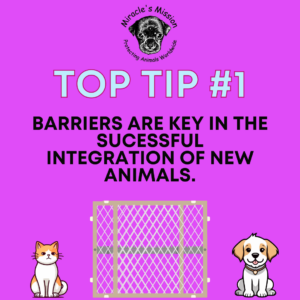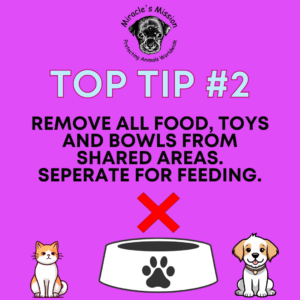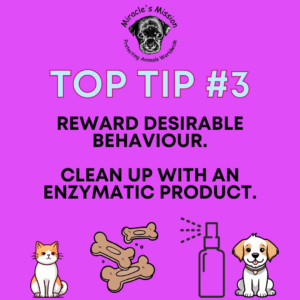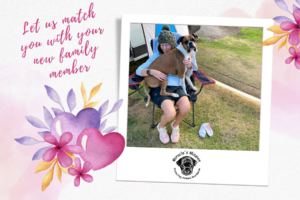Miamish

Whether you are expecting a new dog or a new cat there are some things to think about before they arrive. Making the environment safe and secure for them and any existing household members is paramount.
Preparing your environment
We can never assume that a new animal will immediately integrate with ease, some do, some do not. You will need to create a safe place (not a crate) for your animal to land in when they arrive. Using baby gates to create a pet-safe room or a large pen is ideal. If you can locate it near to the garden access for dogs this would be useful.
Having a “no man’s land” (vacant space) in between your new pet and your existing pets or children would be ideal. This can be created by using a double barrier system and helps when you are training them to feel good around one another. The second barrier means they cannot over face themselves by getting too close.
Dogs and Dogs
If you can, it would be a good idea to carry out a scent-swapping exercise so that the animals can habituate to each other’s scents ahead of an “in person” meeting. Or before they get clear visual exposure to each other in the home.
Tips from our behaviourist.

Cats and Dogs
Cats and small animals could so easily come to serious harm, even in friendly interactions from an overzealous dog. Similarly, a claw to a dogs eye could be a devastating injury. So, for their mutual safety they must be kept separate at least initially and then under close supervision.
When spending time together, your cat needs a solid escape route, and the environment needs to be free from areas where your dog might corner the cat.
Cross-species play can be managed by keeping your dog on a long line until they can be recalled and redirected under those environmental conditions.
Games such as flirt pole (kept low to avoid twisting and jumping), lure chasing will give you opportunity to practice disengagement with their “target object” whether that’s a toy, a cat or another dog.
But that skill needs to be developed in practice, proofed to a high standard and cast iron before you can rely on it in real life where other animals safety (and their own) are at stake.

Expectation setting
So much about whether your dog can live with another dog or cat (or children) will boil down to the lengths you are willing to go to to keep them all safe and calm in the event that it is not a smooth ride in the early days.
Our current advice to people thinking of adding an animals is this:
Unless you are willing to live as a split household in the short, medium or even permanently then please do not add any more animals.
Potty Training 101
A new dog to your home may need to start completely from scratch with potty training.
Similarly, a previously trained dog may regress when rehomed or under stress. Follow this simple guide to get things right:
- Implement a schedule where you take your dog outside every 2 hours for at least 5 minutes. Set an alarm if you need to.
- Praise and reward elimination in the correct place.
- Observe but do not stand over or micromanage as this can cause stress (for you both)
- Keep a potty diary so you can see where YOU are going wrong.
- Clean up any accidents with an enzymatic cleaner and paper towels (not mops or rags)
- Never punish or chastise the animal for a mistake.
- Never expect your animal to hold their toilet for more than 4 hours during their normal waking day.
- Relax! They will get there as long as you keep doing the right things. We have potty trained 100’s of dogs over the years and this method never fails, if the human puts the work in and makes it a priority.

We want every adoption to be a success, so we go to great lengths to assess candidates for suitability for our animals. Our returns rate, as such, is very low.
Please be honest with us and yourselves, about what you can manage and what you can live with in terms of bending and changing your own behaviours, to meet the animal’s individual needs fully.
If you are not a foster or adoptive parent of ours, you can still access help from our resident behaviourist Emma Mclean by contacting her at info@miraclesmission.org or mobile 07311832680 (WhatsApp preferred)
Bear the Boxer in his forever home.

